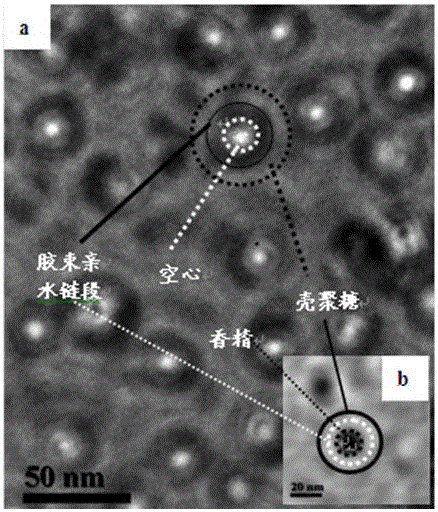Preparation method of chitosan-based sustained-release fragrance nanocomposite microcapsule coating material
A nano-composite and coating material technology, applied in the field of coating materials, can solve problems such as no public reports
- Summary
- Abstract
- Description
- Claims
- Application Information
AI Technical Summary
Problems solved by technology
Method used
Image
Examples
Embodiment 1
[0033] Step 1: Prepare a weak acid solution with a mass fraction of 2%, add chitosan powder to it, the mass ratio of chitosan and weak acid solution is 1:10, ultrasonically treat for 20min, and stir at 60°C for 36h to obtain chitosan sugar solution.
[0034] In step 1, the weak acid is acetic acid;
[0035] Chitosan is a water-soluble low molecular weight chitosan with molecular weight within 1000.
[0036] Step 2: Dissolve the amphiphilic copolymer micelle F127 in an organic solvent to form a homogeneous transparent solution. The mass-volume ratio of the amphiphilic copolymer micelle to the organic solvent is 90 mg: 900 μL; after stirring for 8 hours, add the nanoparticle precursor to it and fragrance molecules, ultrasonic treatment for 30min, the mass-volume-mass ratio of the amphiphilic copolymer micelles to the nanoparticle precursor and the fragrance is 9g:9μL:1mg, and a mixed solution is obtained.
[0037] In step 2, the organic solvent is tetrahydrofuran;
[0038] Th...
Embodiment 2
[0042] Step 1: Prepare a weak acid solution with a mass fraction of 3%, add chitosan powder to it, the mass ratio of chitosan to weak acid solution is 1:10, ultrasonically treat for 30min, and stir at 80°C for 54h to obtain chitosan sugar solution.
[0043] In step 1, the weak acid is acetic acid;
[0044] Chitosan is a water-soluble low molecular weight chitosan with molecular weight within 1000.
[0045] Step 2: Dissolve the amphiphilic copolymer micelles F127 in an organic solvent to form a uniform transparent solution. The mass-volume ratio of the amphiphilic copolymer micelles to the organic solvent is 120 mg: 1350 μL; after stirring for 11 hours, add the nanoparticle precursor to it and essence molecules, sonicated for 55min, the mass-volume-mass ratio of the amphiphilic copolymer micelles to the nanoparticle precursor and the essence was 12g:12μL:2mg, and a mixed solution was obtained.
[0046] In step 2, the organic solvent is tetrahydrofuran;
[0047] The nanoparti...
Embodiment 3
[0051] Step 1: Prepare a weak acid solution with a mass fraction of 4%, add chitosan powder to it, the mass ratio of chitosan and weak acid solution is 1:10, ultrasonically treat for 40min, and stir at 100°C for 72h to obtain chitosan sugar solution.
[0052] In step 1, the weak acid is hydrochloric acid;
[0053] Chitosan is a water-soluble low molecular weight chitosan with molecular weight within 1000.
[0054] Step 2: Dissolve the amphiphilic copolymer micelles F127 in an organic solvent to form a uniform transparent solution. The mass-volume ratio of the amphiphilic copolymer micelles to the organic solvent is 150 mg: 1800 μL; after stirring for 14 hours, add the nanoparticle precursor to it and essence molecules, sonicated for 80min, the mass-volume-mass ratio of the amphiphilic copolymer micelles to the nanoparticle precursor and the essence was 15g: 16μL: 3mg, and a mixed solution was obtained.
[0055] In step 2, the organic solvent is dimethylformamide;
[0056] T...
PUM
 Login to View More
Login to View More Abstract
Description
Claims
Application Information
 Login to View More
Login to View More - R&D
- Intellectual Property
- Life Sciences
- Materials
- Tech Scout
- Unparalleled Data Quality
- Higher Quality Content
- 60% Fewer Hallucinations
Browse by: Latest US Patents, China's latest patents, Technical Efficacy Thesaurus, Application Domain, Technology Topic, Popular Technical Reports.
© 2025 PatSnap. All rights reserved.Legal|Privacy policy|Modern Slavery Act Transparency Statement|Sitemap|About US| Contact US: help@patsnap.com

